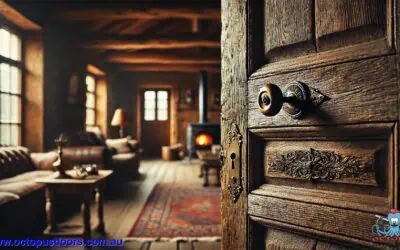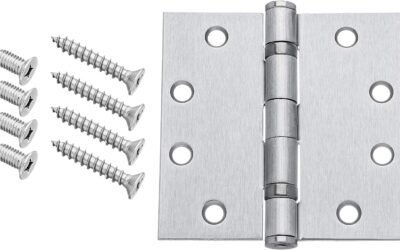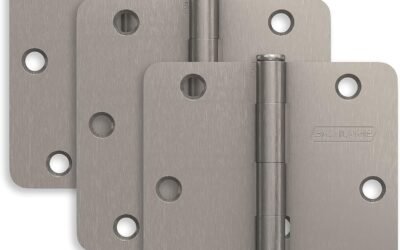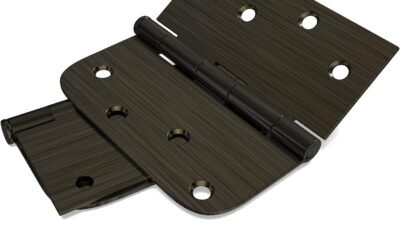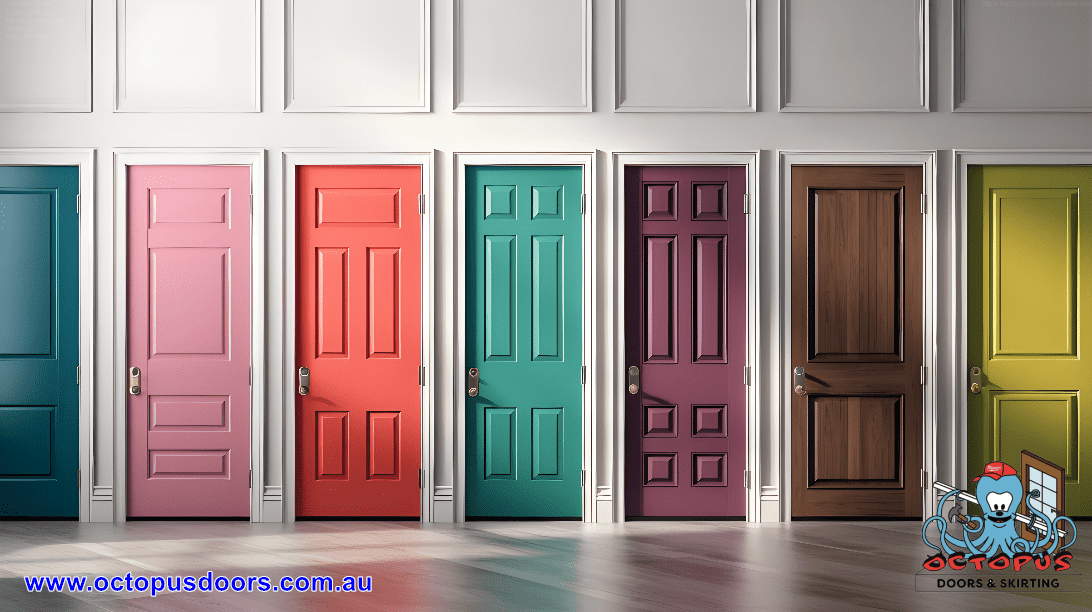
Painting your doors can make a significant impact when it comes to giving your home a fresh, updated look.
With a plethora of paint options available in the market, it can be challenging to determine the best type of paint for your doors. In this article, we’ll explore various paint types, finishes, and techniques to help you decide when painting your interior doors, wooden doors, and door frames.
We’ll also discuss some tips for achieving a professional-looking result without the need for sanding.
Are you choosing the right paint for door frames?
Selecting the ideal paint for door frames depends on the door type and its location. According to Consumer Reports, semi-gloss paint is recommended for exterior doors and trim, as it provides a balance between durability and an attractive sheen. Latex exterior paints offer weather-resistant coverage and are ideal for metal doors. If your door faces harsh weather conditions like rain or snow, opt for rot-resistant paint to ensure lasting protection.
When deciding on the paint finish, keep in mind the durability and shine it offers. Glossy finishes enhance architectural details but may highlight imperfections, such as knicks and blemishes. While high-gloss finishes suit interior doors, semi-gloss paint is more forgiving and effectively conceals flaws.
As for interior doors, trim paint is typically either oil-based or latex-enamel – these are designed for high-impact surfaces. The perfect paint finish for trim is subjective; however, most homeowners prefer a semi-gloss or satin finish.
Sherwin Williams’ Director of Color Marketing, Sue Wadden, says, “A satin sheen creates a pearl-like finish that’s durable and dirt-resistant.” This quote highlights that sheen affects a paint’s longevity, functionality, and appearance.
When painting doors, using the appropriate paint is crucial to avoid peeling and fading. A fresh coat of paint not only hides minor imperfections on a front door but also protects it against harsh outdoor elements and enhances curb appeal.
Pro Tip: Before painting, consider the type and location of the door, the desired durability, and the level of sheen you want. Then, choose between latex or oil-based paint and a suitable finish to achieve the ideal outcome.
What kind of paint do you use on interior doors?
Paint your interior doors with a durable gloss or semi-gloss sheen for easy cleaning. Some of the best options include latex-based or acrylic paints, known for their exceptional performance on interior doors. Of course, if you have a wooden door, you can also consider using chalk paint, milk paint, or any other ideal paint alternatives. Additionally, it’s crucial to select the right finish to achieve the desired look and functionality. Interior paints come in five key finishes: flat, eggshell, satin, semi-gloss, and gloss.
“The ideal paint for interior doors is a balance between durability, sheen, and finish.” – Renowned interior designer Nate Berkus.
Step-by-Step Guide for Painting Interior Doors:
- Preparation is Key: Before you begin, ensure the door is clean and debris-free. Remove any hardware that may obstruct the painting process.
- Brush or Roller? Invest in a high-quality brush or roller, which significantly impacts the final outcome. Take advice from industry experts like Jenny Komenda, who famously said, “The right tool can make all the difference in a DIY project.“
- Thin and Even Coats: Applying paint in thin and even coats guarantees a professional finish. Patience is paramount!
Top Paint Recommendation:
Benjamin Moore’s Advance Paint is highly recommended for interior doors. This paint has garnered praise from professionals like Emily Henderson, who says, “Benjamin Moore Advance provides an excellent finish, and it can cover both latex and oil-based paints.“
Colour Selection:
When deciding on a paint colour for your interior doors, choose versatile options like white or grey, as they complement existing walls and trim. Following this advice from colour expert Maria Killam, your doors will seamlessly blend with your home décor: “Neutral tones allow for a cohesive and harmonious space.“
Following these crucial tips and insights from industry leaders will achieve stunning, long-lasting results when painting your interior doors. Remember, patience and the use of quality materials make all the difference.
Best paint for interior doors and trim?
Selecting the best paint for interior doors and trim depends primarily on the desired durability and ease of cleaning. Gloss and semi-gloss finishes are popular choices, offering an attractive dimension and simpler maintenance. As the renowned interior design expert Kelly Wearstler says, “The more gloss in the paint, the more reflective and protected the surface will be“, which also applies to interior doors and trims.
Why Semi-Gloss Options Dominate
While glossy paints offer a reflective and protective surface, semi-gloss finishes are the most recommended sheen option. They are typically more durable than flat or satin finishes. Acrylic latex paint is another excellent choice for interior trim, as it cures hard and lasts longer.
Pros of Oil-Based Paints
Oil-based paints hold a reputation for being the most durable option, guaranteeing an extended lifespan for your doors and trim. Renowned paint expert, Annie Sloan, supports this notion by stating, “Oil-based paints have a longer-lasting finish and can withstand wear and tear better than other paint types.“
Choosing the Ideal Paint Type for Your Door Material
Selecting the right paint type based on the door material is crucial, with latex-based paints being suitable for most interior doors. However, the best paint for trim and doors also depends upon the specific room in which the door is located.
Considering Moisture Levels in the Room
For rooms without moisture issues, any paint type can suffice. Yet, for doors located in high-moisture areas like bathrooms or kitchens, industry leaders recommend opting for paints resistant to mildew and moisture.
Key Takeaways
The perfect paint for interior doors and trim combines durability, easy cleaning, and a glossy or semi-gloss finish. Choose from the most recommended sheen options, like semi-gloss, using acrylic latex paint for interior trim. Finally, consider the door material and room location when selecting your paint for the best results.

Which paint is best for wooden doors?
Oil-based paint is undoubtedly the top choice for wooden doors, offering optimal wear and protection. While latex paint is a popular option for interior doors, wooden doors benefit greatly from alternatives like chalk paint, milk paint, or acrylic paint. Keep in mind that for these alternative paints, you’ll need to apply a protective topcoat like wax or polyurethane.
When it comes to finishes, gloss and semi-gloss reign supreme for interior doors and trims, thanks to their durability and ease of cleaning. As design expert Kelly Wearstler once said, “A glossy finish adds depth and offers an extra layer of protection.” To ensure you select the right paint, look for those specifically recommended for interior doors, featuring a durable gloss or semi-gloss sheen that facilitates cleaning.
One noteworthy paint option is Benjamin Moore’s Advance paint, suitable for previously painted doors, as it adheres well to latex and oil-based paint. Renowned home renovation expert, Bob Vila, lauds Advance Paint for its “excellent levelling properties,” making it a perfect choice to achieve a professional and seamless finish.
Oil-based paint is the best option for wooden doors, providing superior protection and durability. Consider alternative paints and finishes like gloss or semi-gloss sheens for easy cleaning, and explore highly recommended products such as Benjamin Moore Advance paint for top-notch results.
Is enamel or acrylic paint better for interior doors?
Enamel paint (oil-based) and acrylic paint (water-based) are both suitable options for painting interior doors; however, the best choice depends on the specific requirements of your project. To determine the ideal paint for your interior doors, let’s delve into the properties and capabilities of each type.
Enamel Paint: Best for Frequent Washing and Metal Surfaces
Enamel paint, known for its glossy finish and durability, is an excellent choice for surfaces that need frequent washing or are prone to heavy use. Its oil-based formula makes it resistant to damage, ensuring long-lasting performance. In addition, enamel paint is particularly suitable for painting metal surfaces, as it adheres strongly and provides a smooth finish.
“Enamel paints provide a glassy, hard finish and the color tends to be very saturated,” says Philip Reno, owner of Philip’s Perfect Colors.
Acrylic Paint: Ideal for Indoor Projects and Porous Surfaces
On the other hand, acrylic paint, with its matte finish and water-based formula, is an excellent option for indoor painting projects and porous surfaces. Its flexibility reduces the likelihood of cracking when exposed to extreme weather conditions. Acrylic paint is also fast-drying and has a low odour, allowing rooms to be painted and occupied quickly.
According to artist Tracy Silva Barbosa, “Acrylic paint is versatile, dries quickly, is permanent and waterproof when dry, and is less toxic than oil-based enamels.”
In Conclusion: Choose Enamel or Acrylic Paint Based on Your Project Needs
To summarize, both enamel and acrylic paint can be used for interior doors, but the choice between them lies on the specific needs of your project:
Enamel paint is the top choice when you need a surface that is easily washable, suitable for outdoor applications, or when painting metal surfaces.
Acrylic paint is perfect for indoor painting projects, porous surfaces, and when you need a fast-drying, low-odour solution.
Before starting your project, consider the desired outcome and the surfaces you will work with. Make an informed decision between enamel and acrylic paint to achieve the best results.
What is the most common paint finish for interior doors?
Semi-gloss is the most popular paint finish for interior doors, thanks to its durability, wipe ability, and pristine appearance. Ideally suited for doors that take a beating over time, glossier paints like semi-gloss are more resilient and easier to clean than flatter alternatives.
However, it’s important not to overlook other common options, such as satin and eggshell finishes. While not as glossy as semi-gloss, these finishes offer a good balance between sheen and durability, making them suitable for a variety of interior doors.
When it comes to the paint’s composition, factors like consistency, adhesive properties, longevity, fumes, dry time, and cleanability all come into play. Two types of paint are specifically optimized for interior doors and trim: alkyd/oil-based and acrylic latex/enamel.
Pro Tip: Bob Vila, a trusted home improvement influencer, emphasizes the importance of choosing a durable paint type and finish for interior doors: “Since doors take more abuse than walls, choose a high-quality paint specifically designed for them.”
Let’s break down these two paint types and their respective advantages:
Alkyd/Oil-Based Paints – Known for their robust performance, these paints have excellent adhesion, providing a more complex, more durable finish as well as a smooth, even application. However, they typically involve longer drying times and more noticeable fumes.
Acrylic Latex/Enamel Paints – This environmentally friendly option offers a durable finish with less odour and faster drying times. These paints are also less susceptible to yellowing over time, making them popular for modern home interiors.
Key Takeaway: For an optimal paint finish on your interior doors, consider leaning towards a semi-gloss paint, but don’t hesitate to explore alternatives like satin and eggshell. Additionally, weigh the pros and cons of alkyd/oil-based and acrylic latex/enamel paints to make the best choice according to your preferences and needs.
Should doors be satin or semi-gloss?
Semi-gloss is the preferred finish for interior doors due to its durability, cleanability, and enhanced sense of space. In comparison, satin paint, characterized by its velvety smooth appearance with a touch of gloss, is popular for window frames, doors, and walls. Renowned interior designer Kelly Hoppen once said, “The quality of the finish reveals the quality of the design.” This statement holds especially true when choosing the right paint finish for your spaces.
Semi-gloss vs. Satin: Key Differences
- Reflectiveness: Semi-gloss paint boasts a more reflective surface, making it ideal for small rooms or areas where the illusion of space is critical.
- Durability: Semi-gloss finishes are more hardwearing than satin, easily tolerating daily wear and tear, and essential for high-traffic elements such as doors and trims.
- Cleanability: The semi-gloss finish is easier to clean, thanks to its higher sheen level that allows scrubbing and wiping without damaging the paint.
Both satin and semi-gloss finish present a glossier appearance in comparison to eggshell paint. However, satin maintains a smoother look with a subtle gloss.
Choosing between satin and semi-gloss ultimately depends on your needs and preferences. As a leading paint manufacturer, Benjamin Moore suggests, “Select a sheen based on what the space is used for, the desired design aesthetic, and the amount of natural light.” If durability and cleanability are your primary concerns, a semi-gloss finish might be the best option for your interior doors. Nonetheless, satin remains a viable alternative for a softer, more understated elegance in your living spaces.
Can I use the same paint for doors and walls?
Absolutely! Painting doors the same colour as walls create a seamless, modern, and restful aesthetic that effortlessly elevates your interior design. This approach to a pared-down look makes any space appear sleek and chic. But before you grab your paintbrush, let’s delve into some critical aspects and steps to ensure an exquisite result.
The Significance of Sheen
Remember that the paint you apply to doors typically has a different sheen than wall paint. Leading interior designer Kelly Wearstler advises, “This distinction is important because it affects the overall aesthetic and durability.”
Popular door paint finishes include:
- Semi-gloss: A common choice for interior doors due to its resistance to fingerprints and fast cleaning times.
- Satin: Recommended for trim, this option offers a subtle glow emphasising architectural details.
- Eggshell: An increasingly popular choice, it provides a muted sheen that pairs well with contemporary styles.
Interior design expert Nate Berkus suggests, “To create a harmonious and sophisticated look, opt for a satin finish on trim and a gloss finish on doors.”
Benefits of a Unified Paint Scheme
When you paint doors, walls, and trim the same colour, you unlock a range of aesthetic advantages:
- Amplify Space: Smaller rooms appear larger since uninterrupted colour minimizes visual breaks.
- Create Calm: By eliminating contrast, you foster a relaxing environment.
- Highlight Décor: Your furniture, artwork, and other design elements stand out against a cohesive backdrop.
With these insights from industry leaders and a thoughtful approach to sheen selection, you’re well-equipped to paint your doors and walls the same colour – resulting in an elegant, sophisticated, and relaxing space. So unleash your inner designer and transform your home with this bold, contemporary look.
Do you need specific paint for the doors?
Specific paint is required for doors to achieve the best results. Depending on their location and intended use, interior and exterior doors necessitate different paint types. Leading industry professionals recommend using durable gloss or semi-gloss paint for interior doors, as this sheen is easy to clean and maintain. Well-known experts like Sherwin Williams and Benjamin Moore suggest satin and eggshell finish for interior doors, which balance glossy and flat appearances.
Key Takeaway: The ideal paint finish for interior doors is semi-gloss, offering durability, cleanability, and a pristine look.
Thanks to their easy application and versatile properties, popular interior door choices include latex-based or acrylic paint. Meanwhile, exterior doors demand paint that is resilient against harsh weather conditions. For outdoor doors, experts recommend latex, acrylic, and oil-based paint as strong contenders for the job. Furthermore, epoxy paint is a highly durable option, especially for doors exposed to heavy use or extreme weather conditions.
“Glossy or semi-gloss paint is recommended for outside doors, as the gloss finish blocks out moisture, making both the paint and door last longer.” – Expert Tip from a Professional Painter
In summary, selecting the right paint for doors is crucial, taking into consideration factors such as location, material, and purpose. By using industry-approved paint types and finishes, you can ensure lasting beauty and functionality for your doors.

What is the easiest way to paint interior doors?
Painting interior doors can be a breeze if you follow these simple steps: choose the right paint, prepare the door, apply paint using a brush or roller, and allow ample drying time before reinstallation. Let’s dive into each step in more detail.
Step 1: Choose the Right Paint
Experts, such as those at Sherwin-Williams and Behr, suggest using high-quality paint specifically formulated for interior doors. A durable gloss or semi-gloss finish is recommended, as these options are easy to clean and maintain.
Step 2: Prepare the Door
To ensure the paint sticks well and looks great, you should clean the door thoroughly and remove any hardware. If you’re working with a bare wood door, prime it using two coats of primer before applying paint. Renowned interior designer, Emily Henderson, advocates for proper door preparation to achieve professional-looking results.
Step 3: Paint the Door
When it comes to painting, start with the inside hinge edge, and work your way around the door in one direction, using either a brush or roller. Begin by painting from the inside bottom, moving across the header and down the striker side. For the narrow space, opt for a brush to ensure full coverage. Bob Vila, a home improvement expert, recommends applying paint quickly and evenly, maintaining a wet edge to achieve a smooth finish.
“Remember: painting quickly and maintaining a wet edge allows for an even appearance without telltale brush marks,” says Bob Vila, a leading authority in home improvement.
Step 4: Allow Time for Drying
Let the paint dry completely for a polished result before reattaching the hardware and reinstalling the door. This way, you avoid unwanted smudging or chipping.
In conclusion, hassle-free interior door painting is achievable when you choose the ideal paint, meticulously prepare the door, use the proper tools and techniques, and give the paint sufficient time to dry before reinstalling. Following this proven method, you’ll have beautifully painted doors that enhance your living spaces.
How do you paint interior doors without brush marks?
To achieve a flawless paint job on interior doors without any brush marks, follow these essential steps:
Select a semi-gloss latex paint: This is durable and easy to clean, making it an ideal choice for interior doors. Consider the door material and location when selecting the best paint. Renowned interior designer Kelly Wearstler recommends paying attention to how the paint colour will interact with other elements in the space, stating that “doors should create harmony with the rest of the room.”
Remove the door from its hinges: Lay it flat on a pair of sawhorses or a worktable for easy access and greater painting control.
Sand and clean the door: Lightly sand the door to remove any imperfections and wipe it thoroughly with a damp cloth to eliminate dust and debris that could compromise the paint finish.
Choose a high-quality brush or roller: Apply the paint using a top-tier brush or roller for an even coat. Start with the recessed areas, and work your way out to the door’s edges. As painting expert Bob Vila advises, investing in a good-quality brush or roller is essential to achieve a professional finish.
Add a paint additive like Floetrol: This addition will help the paint level out and minimize the appearance of brush marks.
Paint in the direction of the wood grain: Following the natural grain of the wood will ensure a more seamless result, free of brush marks.
Consider a second coat and allow the paint to dry: Depending on the door colour and desired finish, a second coat of paint may be necessary. Don’t forget to let the paint dry completely before rehanging the door.
In summary, for an impeccable, brush-mark-free interior door painting project, remember to choose the right paint, properly prepare the door, use top-notch painting tools, follow the grain of the wood, and incorporate paint additives. By following these steps and taking guidance from industry experts like Kelly Wearstler and Bob Vila, you’ll achieve an enviable finish that elevates the aesthetics of your living space.
Can you paint interior doors without sanding?
The best approach to painting interior doors is sanding them first, ensuring a smooth, even surface for the paint to adhere properly. While skipping this step is possible, experts recommend lightly sanding the door to achieve flawless results.
“Sanding removes any paint or coating on the door, promoting greater adhesion and creating a surface where the paint can stick better,” explains Jason Parker, a renowned painting expert.
Moreover, if your door has a glossy or shiny finish, removing it by sanding is crucial. This action will eliminate any slippery surfaces, allowing the new paint to hold tighter and last longer. On the other hand, suppose the door is already painted and remains in good condition. In that case, you might be able to forgo sanding altogether.
Key Takeaways:
- Sanding the door ensures a smooth surface to adhere to the paint.
- Removing any glossy or shiny areas is important for achieving better paint adhesion.
- Skipping the sanding process might be an option if the door is in excellent pre-painted condition.
To guarantee a professional and long-lasting result, it is wise to lightly sand your interior doors before painting them. By following this expert advice, your doors will look fantastic and have a durable finish, leaving a lasting impression on anyone visiting your home.
Choosing the Right Paint for Your Doors
Outro Paragraph: In conclusion, selecting the right paint for your doors can greatly enhance the overall aesthetic of your home. By considering factors such as the type of door material, paint finish, and desired look, you can make an informed decision about the best paint to use on your doors.
Whether you opt for enamel, acrylic, or a specific paint type, remember to follow proper painting techniques to achieve a smooth, flawless finish.
With the right paint and approach, you can transform your doors and elevate the appearance of your living space.
Related Articles:
Why Was the Ring Doorbell Made? The Complete Story Unveiled
A Doorbell that Changed the Game Have you ever missed a visitor because you couldn't hear the doorbell? Jamie Siminoff did, and it sparked a billion-dollar idea. This is the story of how a simple problem led to a revolution in home security, forever changing...
Unlocking the Secrets: What is the Standard Door Size in NZ?
G'day, Kiwi homeowners and DIY enthusiasts! Have you ever scratched your head in the middle of a home improvement project and wondered about door sizes? Well, you're not alone. Let's dive into the world of standard door sizes in New Zealand - it's more fascinating...
Dynasty Hardware Door Hinge Review
Dynasty Hardware Door Hinge Review: Discover the quality and elegance of Dynasty Hardware’s Commercial Grade Ball Bearing Door Hinge (4-1/2 x 4-1/2, Brushed Chrome). A must-have upgrade!
Unlocking the Secrets: What is the Size of an Industrial Door?
Ever walked into a warehouse and wondered, "How do they fit those massive trucks through those doors?" Well, my friend, you're about to embark on a journey into the fascinating world of industrial door sizes! Grab a cup of coffee, and let's dive right in. As someone...
Do Plantation Shutters Block Out Light? A Homeowner’s Guide to Elegant Light Control
It's a lazy Sunday morning, and you're comfortably in bed. The soft glow of dawn creeps through your windows, gently coaxing you awake. But wait - you're not ready to face the day just yet. You reach out, adjust your window coverings, and voila! The room is enveloped...
6″ Hidden Door Hinge Review
Upgrade your home with the 6″ Hidden Door Hinge! Achieve a sleek, modern look with durable, silent, and easy-to-install invisible hinges. Perfect for hidden doors and feature walls.
What is the Height Measurement of a Door Frame? A Homeowner’s Guide
Hey there, fellow home improvement enthusiasts! You were staring at a door frame, scratching your head, and wondering, "Just how tall is this thing anyway?" Well, you're not alone. As someone who's been around the block (and through countless doorways) a few times,...
Unlocking Freedom: Can You Put a Dog Flap in a Double Glazed Door?
Have you ever been abruptly woken up at the crack of dawn (or maybe even earlier!) by the insistent scratching of your furry friend at the door? We've all been there! They have a built-in alarm clock that goes off as you drift into a peaceful sleep. Now, imagine a...
Schlage 3.5″ Door Hinge Review
Upgrade your home with Schlage 3.5″ Door Hinges in Satin Nickel. This review covers their durability, ease of installation, and stylish design. Discover more now!
goldenwarm 3 Pack Brushed Nickel Door Hinges Review
Discover the elegance and durability of the goldenwarm 3 Pack Brushed Nickel Door Hinges in our detailed review. Perfect blend of style and functionality!


